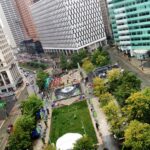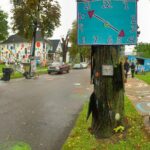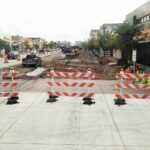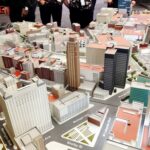
Motor City Rust & Royalty
- Dev Team
- 19 Oct 2016
Hamilton Meets Detroit On An Urban Bus Tour
The sky was a dark shade of grey and the air was cold and damp as a busload of curious Hamiltonians set off on urbanicity’s Detroit urban bus tour on Friday, September 30th. It was only 7:30 in the morning, and so many passengers were still rubbing the sleep out of their eyes as some joked about how the weather seemed fitting for a trip to the most depressed of the rustbelt cities. Interestingly enough, it was the exact same weather that our 2013 urbanicity bus tour to Detroit had enjoyed on its first day. Very few on the bus had any idea of what awaited them in the motor city.
 I often say that Detroit is the most compelling of the rustbelt cities because of the extremity of its story. It was far larger than Buffalo, Pittsburgh, Cleveland, or Hamilton, and it became even wealthier than any of them individually. It also crashed the hardest, and has suffered the most. In a place of such extremes,it is no surprise that it is now also the site of some of the most radical urban renewal efforts by broke individuals and billionaire tycoons alike. Dan Gilbert, owner of the Quicken Loans group of companies, has increased his holdings to 92 buildings (from 30 in 2013); bringing his ownership of Detroit’s central business district to roughly 40% of all property in the area. Our group had the opportunity to tour some of his vast urban empire, including the Cube, a massive office building full of young hipsters riding scooters between their sit-stand workstations while sipping free slurpies and selling mortgages. At one point in this segment of the tour, we assembled at a gigantic scale model of downtown Detroit. The buildings with orange on their roofs were owned by Dan Gilbert and his companies. The next day we found out that our tour of Gilbert’s buildings was rerouted because he was hosting an event with none other than Donald Trump.
I often say that Detroit is the most compelling of the rustbelt cities because of the extremity of its story. It was far larger than Buffalo, Pittsburgh, Cleveland, or Hamilton, and it became even wealthier than any of them individually. It also crashed the hardest, and has suffered the most. In a place of such extremes,it is no surprise that it is now also the site of some of the most radical urban renewal efforts by broke individuals and billionaire tycoons alike. Dan Gilbert, owner of the Quicken Loans group of companies, has increased his holdings to 92 buildings (from 30 in 2013); bringing his ownership of Detroit’s central business district to roughly 40% of all property in the area. Our group had the opportunity to tour some of his vast urban empire, including the Cube, a massive office building full of young hipsters riding scooters between their sit-stand workstations while sipping free slurpies and selling mortgages. At one point in this segment of the tour, we assembled at a gigantic scale model of downtown Detroit. The buildings with orange on their roofs were owned by Dan Gilbert and his companies. The next day we found out that our tour of Gilbert’s buildings was rerouted because he was hosting an event with none other than Donald Trump.
Detroit is a city that lived and died by the automobile. In fact, many of its roads are still nine lanes wide; built to accommodate the tremendous traffic that once used to flow from the ever-expanding suburbs to the once-vibrant downtown and the many manufacturing plants surrounding the central business district. Today, these streets are largely vacant and bordered by endless storefronts that have long sat empty. The beautiful old banks on every corner have been burned down or converted into churches with names that invoke themes of restoration, renaissance, faithfulness, and mercy. Now, most people only venture into Detroit from the 132 surrounding municipalities for a baseball game at Comerica Park or football failure at Ford Field.
Many neighbourhoods within the boundaries of Detroit are filled with derelict homes, empty lots, and overgrown trees. Some areas, however, like Boston-Edison and the Indian Village have remained vibrant and boast beautiful rows of century homes that speak to the city’s former glory. Tyree Guyton returned to his neighbourhood thirty years ago after serving his country in the military. What he returned to shocked him, and compelled him to respond with art. He began painting polka dots on the homes and sidewalks of his neighbourhood, and started building art installations using the garbage people dumped on the empty lots on his street. This three-block area has become internationally famous as the Heidelberg Project.
Things are changing, however, in the motor city. The city’s great avenue, Woodward/M-1, has just been rebuilt with a little more than three miles of light rail transit installed, and new condominiums, boutiques, breweries, and retail have begun to flock to its route, eagerly awaiting the start of service in 2017. In an all too familiar example of governmental failure, most public funding for the LRT project has fallen through. Detroit is used to governments failing it however, and private citizens and businesses have stepped up to fund the project themselves. It’s a city with undying determination. As it says on the T-shirts many locals wear, “Nothing stops Detroit”.
The mood on the bus during our return trip was energetic. While everyone was tired from the intense two days of touring, we were all energized by the raw passion of the people we met and the determination of the city we explored. Coming from a city like Hamilton, which has been dismissed for decades, and has seen economic hardship (albeit minor when compared to Detroit), our tour group seemed to develop a hopeful empathy for Detroit. We know that cities can come back. In the case of Detroit, this comeback will be harder and longer than it has been for Hamilton. But Detroiters are ready for it with or without the help of their governments or outside opinions. Just look to their city’s prophetic motto,”We hope for better things. It shall rise from the ashes”
Comments 0
There are no comments






Add comment